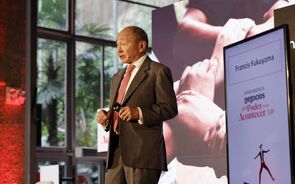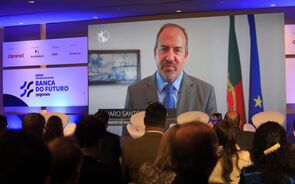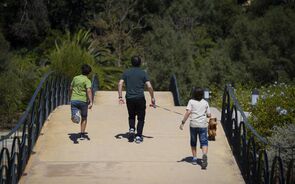555-seat Airbus to debut / A380
4 mensagens
|Página 1 de 1
Acções da EADS caem 2% no dia em que apresenta maior avião do mundo
As acções da European Aeronautic Defense & Space (EADS) caíram um máximo de 2,74% no dia em que a sua participada Airbus apresentou o maior avião do mundo – o «A380».
As acções da European Aeronautic Defense & Space (EADS) caíram um máximo de 2,74% no dia em que a sua participada Airbus apresentou o maior avião do mundo – o «A380».
Este novo avião, que vai concorrer com o modelo «747» da Boeing, foi hoje apresentado em Toulouse, em França, e pesa entre 0,4% a 0,5% menos do que o previsto, disse o presidente operacional da Airbus, Gustav Humbert em entrevista telefónica à Bloomberg, reiterando que o custo de operação será 15% inferior ao «747» da sua concorrente.
No entanto o preço do novo avião será de 280 milhões de dólares (214,3 milhões de euros), o que compara com entre o preço de entre 198 e 227 milhões de dólares (151,6 e 173,7 milhões de euros) do «747-400», última versão da Boeing.
A fabricante de aviões detida pela EADS estimou, o mês passado, que iria conseguir até 700 contratos para o «A380» nos próximos 20 anos, de um mercado total de 1.250 aviões que sentam pelo menos 400 passageiros e de 398 versões fretadas. Por outro lado, as previsões da Boeing relativamente a grandes aviões são apenas um terço do esperado pela Airbus.
Em relação ao peso do avião Humbert explicou que «tivemos um problema» com esse pormenor que foi resolvido com materiais mais leves, acrescentando que «estamos certos que não vamos ter que pagar multas».
O «A380», no valor de 12 mil milhões de euros, foi 15% mais do que o previsto uma vez que a fabricante de aviões teve que satisfazer as garantias de peso aos seus clientes e os testes finais de voo. O novo modelo vai ser pesado no total antes do primeiro teste de voo, previsto para o final de Março ou início de Abril, disse o mesmo responsável.
A cerimónia de apresentação do maior avião do mundo contou com a presença do presidente da França, Jacques Chirac, do chanceler alemão, Gerhard Schroeder, do primeiro-ministro espanhol José Luís Rodriguez Zapatero e do primeiro-ministro inglês Tony Blair que tiveram oportunidade de discursar.
As acções da EADS seguiam a cair 1,56% para os 23,33 dólares (17,9 euros).
-
Visitante
-
Visitante
Um dia histórico...
...para a aviação e para a Europa. Pela 1ª vez desde a 2ª guerra mundial uma empresa europeia consegue colocar-se à frente de uma empresa americana de forma tão expressiva em termos de aviação civil!!!
Ainda por cima num segmento onde não há concorrência pois a Boeing desisitiu de concorrer nos aparelhos de igual dimensão ao A380.
Claro que as entidades reguladoras americanas vão inventar medidas e regulações para limitar o acesso deste aparelho aos states (aconteceu o mesmo com o Concorde, que fazia demasiado barulho ou demasiada poluição...).
Mas o certo é que o A380, para além de inovador, é capaz de ser o instrumento para colocar a Airbus à frente da Boeing de uma vez por todas.
Viva a Europa!!!
P.
Ainda por cima num segmento onde não há concorrência pois a Boeing desisitiu de concorrer nos aparelhos de igual dimensão ao A380.
Claro que as entidades reguladoras americanas vão inventar medidas e regulações para limitar o acesso deste aparelho aos states (aconteceu o mesmo com o Concorde, que fazia demasiado barulho ou demasiada poluição...).
Mas o certo é que o A380, para além de inovador, é capaz de ser o instrumento para colocar a Airbus à frente da Boeing de uma vez por todas.
Viva a Europa!!!
P.
-
Visitante
555-seat Airbus to debut / A380
http://www.airbus.com/product/a380_backgrounder.asp
555-seat Airbus to debut
BY SYLVIA ADCOCK
STAFF WRITER
January 18, 2005
The champagne will be flowing as airline chief executives and European heads of state gather in Toulouse, France, Tuesday for the unveiling of the largest passenger jet in history.
Across the Atlantic, the Port Authority is getting ready to sharpen the bulldozer blades.
Kennedy Airport will need $120-million worth of renovations -- including widening the runways, moving a taxiway away from the terminal and strengthening bridges -- in order to safely accommodate the Airbus 380, a superjumbo double-decker that has a wingspan nearly the length of a football field.
Some of the new construction will be needed just to make sure that the wingtips of the A380 don't hit other planes or trucks. That means a main taxiway will have to be completely relocated 16 feet farther away from the terminal.
"We have to look at our design standards and make sure the aircraft can safely operate," said John Dermody, an engineer with the Federal Aviation Administration, who has been working with the Port Authority on the improvements.
The giant four-engine plane is Airbus' bid to replace the 35-year-old Boeing 747, which Tuesday is the largest passenger jet flying. While the 747 has a distinctive hump behind the cockpit that holds a small upper deck, the A380's two decks run the entire length of the fuselage. It will accommodate 555 passengers in a configuration of economy, business and first class -- although the cabin could be configured to hold far more if premium classes were eliminated. That compares to a typical Boeing 747's payload of 416 passengers in three classes.
Airlines that fly into Kennedy that have placed orders for the A380 include Lufthansa, Virgin Atlantic, Air France, Singapore and Emirates. The first plane off the assembly line likely will be delivered to Singapore and fly first to San Francisco International Airport, which recently added a new terminal designed to accommodate the A380.
Other airports around the county expected to see the A380 in the next two years include Los Angeles International and Chicago O'Hare. At Kennedy, it's not possible to build a new runway or totally redesign the taxiways, so airport planners and the FAA have been working to figure out ways to minimize the impact.
The FAA already has conducted a high-tech study of how much a Boeing 747 drifts off the centerline as it taxis, tracking the planes for months as they trundled down the taxiways at Kennedy and in Anchorage. That information was used to determine just how far the centerline of a taxiway needed to be from another taxiway, to make sure that the distances required had allowances for pilots who don't always stay exactly in the center of the road.
The FAA also expects to restrict the taxiing speed of the A380 to 15 mph, while other large jets can taxi at 20 to 25 mph. The reduced speed will help keep the A380 from drifting off the centerline. The FAA's Dermody said he also expects the A380 to have a designated route from runway to gate, and because its tail is 15 feet higher than the tail of a 747, the A380 won't be able to taxi next to a runway where planes are taking off or landing.
The airport's runways will be widened from 150 feet to 200 feet. The four bridges that carry aircraft over the JFK Expressway and the Van Wyck will be reinforced -- even though they were shored up several years ago to handle the Boeing 777 and another large Airbus plane, the A340. And the pavement in front of selected gates at Terminal One and Terminal Four will have to be strengthened to handle the 1.2-million-pound A380.
Some of the changes are already under way, and several segments of taxiway redesign have been completed. The Port Authority says the flying public won't notice the changes because construction will be phased in gradually.
It was never an option for Kennedy Airport to say no to the A380, said Port Authority Chairman Charles Gargano. Gargano said in an interview last week that the economic impact of the A380 in its first full year of operation at Kennedy is estimated at $82 million, including $32-million worth of new jobs at the airport.
Gargano said the airport also will benefit because the use of larger planes helps keep down delays, while smaller jets with fewer passengers can lead to backups in the sky. "In the future, we need to have less planes with more capacity," he said.
It's not clear which airline will be the first to bring the A380 to Kennedy. Virgin Atlantic hopes to use the big plane on its New York-London routes, and is working with airports to figure out what changes are needed in the terminals to make sure the boarding process goes smoothly.
"We want to make sure people get the same level of ground sevice," said Virgin spokeswoman Brooke Lawer. "You don't want to have all these people waiting hours to get on the plane."
The ceremony Tuesday will be the first public viewing of the A380 outside the factory walls, but the plane has not yet flown. Test flights will begin this spring.
555-seat Airbus to debut
BY SYLVIA ADCOCK
STAFF WRITER
January 18, 2005
The champagne will be flowing as airline chief executives and European heads of state gather in Toulouse, France, Tuesday for the unveiling of the largest passenger jet in history.
Across the Atlantic, the Port Authority is getting ready to sharpen the bulldozer blades.
Kennedy Airport will need $120-million worth of renovations -- including widening the runways, moving a taxiway away from the terminal and strengthening bridges -- in order to safely accommodate the Airbus 380, a superjumbo double-decker that has a wingspan nearly the length of a football field.
Some of the new construction will be needed just to make sure that the wingtips of the A380 don't hit other planes or trucks. That means a main taxiway will have to be completely relocated 16 feet farther away from the terminal.
"We have to look at our design standards and make sure the aircraft can safely operate," said John Dermody, an engineer with the Federal Aviation Administration, who has been working with the Port Authority on the improvements.
The giant four-engine plane is Airbus' bid to replace the 35-year-old Boeing 747, which Tuesday is the largest passenger jet flying. While the 747 has a distinctive hump behind the cockpit that holds a small upper deck, the A380's two decks run the entire length of the fuselage. It will accommodate 555 passengers in a configuration of economy, business and first class -- although the cabin could be configured to hold far more if premium classes were eliminated. That compares to a typical Boeing 747's payload of 416 passengers in three classes.
Airlines that fly into Kennedy that have placed orders for the A380 include Lufthansa, Virgin Atlantic, Air France, Singapore and Emirates. The first plane off the assembly line likely will be delivered to Singapore and fly first to San Francisco International Airport, which recently added a new terminal designed to accommodate the A380.
Other airports around the county expected to see the A380 in the next two years include Los Angeles International and Chicago O'Hare. At Kennedy, it's not possible to build a new runway or totally redesign the taxiways, so airport planners and the FAA have been working to figure out ways to minimize the impact.
The FAA already has conducted a high-tech study of how much a Boeing 747 drifts off the centerline as it taxis, tracking the planes for months as they trundled down the taxiways at Kennedy and in Anchorage. That information was used to determine just how far the centerline of a taxiway needed to be from another taxiway, to make sure that the distances required had allowances for pilots who don't always stay exactly in the center of the road.
The FAA also expects to restrict the taxiing speed of the A380 to 15 mph, while other large jets can taxi at 20 to 25 mph. The reduced speed will help keep the A380 from drifting off the centerline. The FAA's Dermody said he also expects the A380 to have a designated route from runway to gate, and because its tail is 15 feet higher than the tail of a 747, the A380 won't be able to taxi next to a runway where planes are taking off or landing.
The airport's runways will be widened from 150 feet to 200 feet. The four bridges that carry aircraft over the JFK Expressway and the Van Wyck will be reinforced -- even though they were shored up several years ago to handle the Boeing 777 and another large Airbus plane, the A340. And the pavement in front of selected gates at Terminal One and Terminal Four will have to be strengthened to handle the 1.2-million-pound A380.
Some of the changes are already under way, and several segments of taxiway redesign have been completed. The Port Authority says the flying public won't notice the changes because construction will be phased in gradually.
It was never an option for Kennedy Airport to say no to the A380, said Port Authority Chairman Charles Gargano. Gargano said in an interview last week that the economic impact of the A380 in its first full year of operation at Kennedy is estimated at $82 million, including $32-million worth of new jobs at the airport.
Gargano said the airport also will benefit because the use of larger planes helps keep down delays, while smaller jets with fewer passengers can lead to backups in the sky. "In the future, we need to have less planes with more capacity," he said.
It's not clear which airline will be the first to bring the A380 to Kennedy. Virgin Atlantic hopes to use the big plane on its New York-London routes, and is working with airports to figure out what changes are needed in the terminals to make sure the boarding process goes smoothly.
"We want to make sure people get the same level of ground sevice," said Virgin spokeswoman Brooke Lawer. "You don't want to have all these people waiting hours to get on the plane."
The ceremony Tuesday will be the first public viewing of the A380 outside the factory walls, but the plane has not yet flown. Test flights will begin this spring.
-
Visitante
4 mensagens
|Página 1 de 1
Quem está ligado:
Utilizadores a ver este Fórum: cali010201, hugob0ss, m-m, malakas, Mr.Warrior, MR32, Nuno V, nunorpsilva, PAULOJOAO, paulopereira.pp36.pp, SerCyc, Shift72, Simplório, trilhos2006, yggy e 179 visitantes


